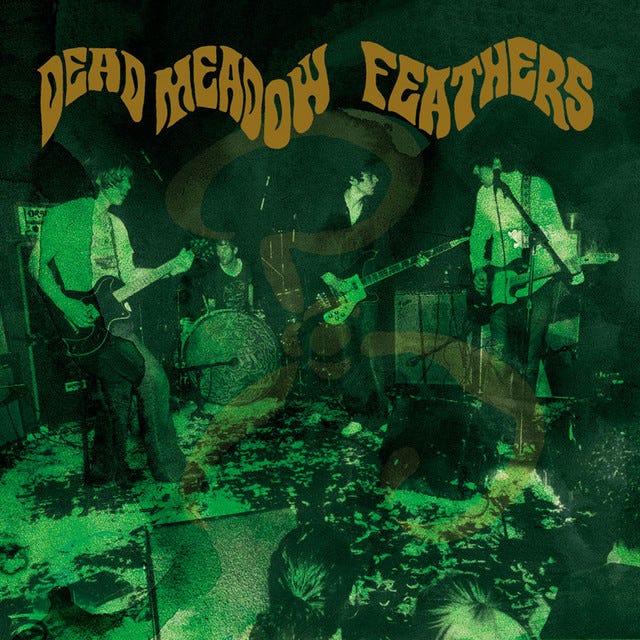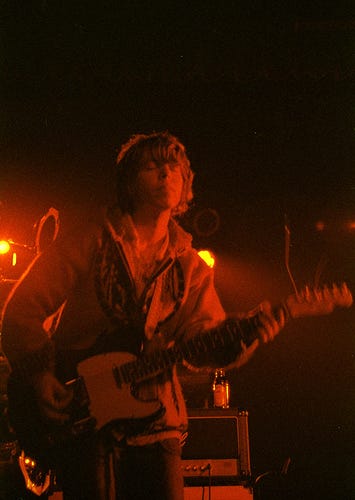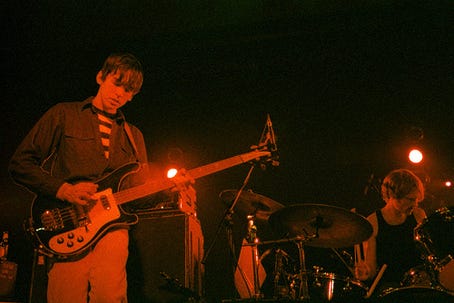Feathers: Ode to a Hidden Gem
After almost two decades, Dead Meadow's fifth release is still one of psych rock's greatest accomplishments.
When talking of defining albums in psychedelic rock, albums that are universally known are typical classics like Dark Side of the Moon, Easter Everywhere, or maybe Surrealistic Pillow; what too many people aren’t aware of, however, are the expansive soundscapes of Dead Meadow’s 2005 release Feathers.
In 2003, Cory Shane (formerly of Hollow Mountain) was invited to play as a secondary guitarist for Dead Meadow’s set-closers, eventually accompanying the band for the entirety of their sets, setting the barn ablaze, so to speak, and starting a short-lived but unique era in the band’s legacy. The stylistic change seems like a natural transition from their previous home-recorded effort, Shivering King and Others, allowing the band to lay back in the ethereal pools to come.
The way that the additional guitar allowed Jason Simon and Cory Shane to play off of one another is a dynamic that few other bands have accomplished so well, bringing to mind the textures of the Brian Jonestown Massacre, with more of a Hendrixian tilt beneath the oceans of wah, creating a quality of endless depth, like a bottomless well, shimmering on the surface, dark and shadowy within. Once submerged, the vast expanses can take the listener in any direction, creating a Tolkienesque openness while painting the sky with different shades of luminescence. How the band plays between lofty nostalgia, floating like snow, into the heavy darkness of being trapped in an endless conflict between greater forces, is admirable (all that can be—has been—will be again).
As is the case of many great artists, sometimes strife creates the most memorable of pieces. During the recording sessions of Feathers, Shane and Simon were both caught in a spell of heavy drug use, not to mention the producer Bob Ebeling (hired by Matador Records after deciding that Steve Albini was too expensive)—with previous production credits on Eminem’s Marshall Mathers LP—was also caught in a bender of his own. The fact that the record turned out as it did is incredible considering the tensions between the band and the producer, whether due to the drugs, Ebeling punching Simon in the head, the ill omen of the neighbouring building being set aflame during a recording session, or being plagued by breathy demons. Simon sums up their collective state well in “Get Up On Down” off the record: “some get healthy—some get sick—some try and some try to not exist”.
It’s important to note the spectacular musicianship of the entire band in the process of making the record, having the skeleton of the album recorded live-off-the-floor, allowing bassist Steve Kille and drummer Stephen McCarty to lock into perfection, carrying the songs forward and allowing them to breathe, leaving Simon and Shane room to scrap the guitars and re-record them into a dense web along with the vocals at a later date in the basement of Pirate House in DC.
Furthest of all from their previous releases is Cory Shane’s “Stacy’s Song”, with a jangly acoustic guitar at its base and wispy textures of echoey guitar lines that pull at the heartstrings of even the most “straight and narrow” of listeners: Shane’s vocals breeze over the track like an open field on a summer’s night. Throughout the album, it’s obvious that the voice of Jason Simon has gained more depth as well. His lyrics, when decipherable, reveal a philosophical evocation laced with beautiful imagery, as heard in the epic “Eyeless Gaze All Eye / Don’t Tell the Riverman”, which starts with heavy Zeppelin-like leads (wolves howl at my skies—snakes fill my head with lies), ending in a gentle transition downstream into the realms of Floydian slides that lull the listener through streams of tranquility.
There’s something blissful about the way that snowfall can capture memories and bring them flooding back into being, and that must’ve been the feeling at the Bowery Ballroom as Anton Newcombe was tearing through pillows mid-set, sending feathers floating down over the stage, and it seems fitting in its way to adopt the name Feathers. The album has a deep nostalgia to it that leaves the heart floating peacefully along, even amidst the darkness that pulls down around it. The green murkiness of the album cover conveys the atmosphere well (with the “Yellow Sign” of Robert William Chambers’ King in Yellow faded beneath): the band lining the stage mid-song, an audience in rapt attention, golden album title waving psychedelically overhead.
Somewhere along the way, personal squabbles between bandmates led to the exit of Cory Shane, and the band returned to their original formation as a three-piece, who still continue to put out top-notch music to this day (with varying drummers). With the release of such a perfect jewel of an album, it’s baffling to wonder how Feathers isn’t as well-received as other classic or contemporary psych albums. Dead Meadow created what is arguably one of the best/most expansive records of all time in the mid-2000s, and there’s no clear indication that their label at the time [Matador Records] or the broader public is even aware of the masterful craft of their creation—but maybe that’s not the point. What matters is that they’re doing it right.
Long live Dead Meadow and Cory Shane.
Works Cited
Dead Meadow, Feathers. Tekeli-Li! Records, 2019 - Under license from Matador Records, 2005 - Matador Records under exclusive license to Dead Meadow.







